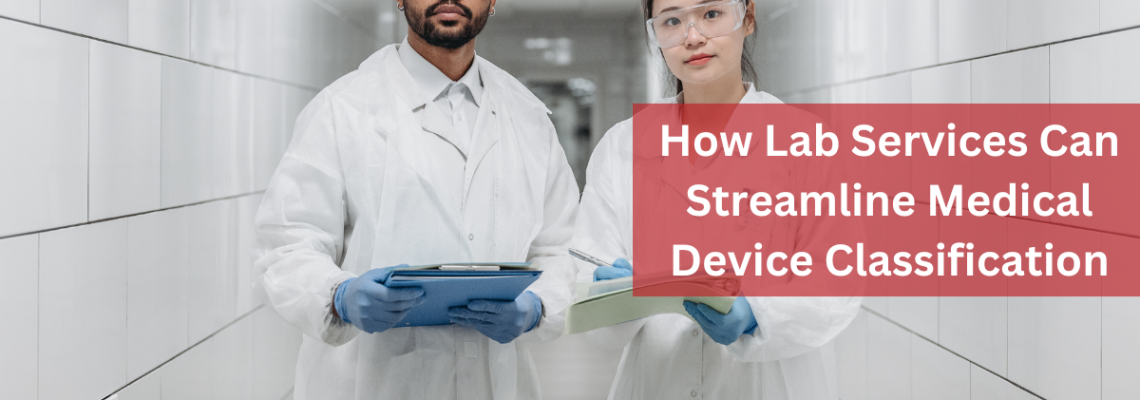Medical device classification is a critical step in bringing new devices to market, as it determines the regulatory path required for approval. Given the complexity and regional differences in classification standards, manufacturers need efficient, reliable ways to ensure their devices are accurately classified. Lab services play a crucial role in this process by offering comprehensive testing, risk assessments, and expert consultation. These services help manufacturers navigate the complex landscape of regulatory requirements, avoid costly misclassifications, and accelerate market entry.
What is Medical Device Classification?
Medical device classification systems are established by regulatory bodies like the U.S. FDA and the European Union MDR to categorize devices based on their potential risk to patients and users. The classification influences the level of scrutiny, testing, and documentation a device must undergo before it can be legally marketed.
In the U.S., devices are classified into three categories:
- Class I (Low Risk): These devices, such as bandages or stethoscopes, are subject to general controls.
- Class II (Moderate Risk): Devices like infusion pumps and powered wheelchairs fall here, requiring additional special controls.
- Class III (High Risk): These are life-sustaining or implantable devices, like pacemakers, that require the most rigorous premarket approval (PMA).
In the EU, devices are categorized slightly differently, with additional subdivisions such as Class IIa, IIb, and III, reflecting the degree of risk and control needed. Factors influencing classification include intended use, the invasiveness of the device, and whether it interacts with sensitive organs.
Why Accurate Classification Matters
Accurate classification is fundamental for ensuring compliance with regulatory standards, which protect patient safety and uphold device efficacy. Misclassification can delay market entry, increase costs, and lead to legal repercussions. An over- or under-classified device may either undergo unnecessary regulatory scrutiny or face rejection due to inadequate testing. Getting classification right from the outset is essential to maintain timelines, control costs, and protect the manufacturer’s reputation.
The Role of Lab Services in Streamlining Classification
Lab services streamline the classification process by providing essential testing and risk assessment services. These services help validate a device’s safety and compatibility with biological systems, while also offering the data needed for regulatory submissions.
Extractables and Leachables (E&L) Testing
E&L testing identifies potentially harmful chemicals that might migrate from the device materials into the patient’s body. This is crucial for ensuring that the device materials are safe for their intended use, particularly for long-term implantable devices. By analyzing the chemical composition of device materials under simulated conditions, lab services ensure compliance with both FDA and EU MDR standards.
Biocompatibility Testing
Biocompatibility testing assesses how the device’s materials interact with biological systems. The tests evaluate whether the device causes adverse effects like toxicity or immunological reactions. This is especially important for higher-risk devices, as improper material selection can lead to device failures and patient harm. Labs like Jordi Labs conduct biocompatibility testing in alignment with ISO 10993 standards, ensuring that the devices are safe for human use.
Toxicological Risk Assessments
Toxicological risk assessments (TRA) evaluate the potential health risks associated with device materials. Lab services offer toxicology expertise to determine safe exposure levels and potential risks, helping to establish a clear toxicological profile for the device. This aids in determining the appropriate device classification and supports robust regulatory submissions.
Failure Analysis
When devices fail during premarket testing, it’s crucial to understand why. Lab services offer failure analysis to pinpoint the root cause of device malfunctions, whether it’s due to material degradation, design flaws, or manufacturing defects. By identifying and rectifying these issues early in the development cycle, manufacturers can avoid costly redesigns and retesting.
Consequences of Misclassification
The consequences of misclassifying a medical device can be severe. Regulatory bodies may require additional testing, leading to delays and increased costs. In the worst-case scenario, misclassification could result in legal penalties or patient safety issues. Correct classification from the start minimizes these risks and prevents market rejections, product recalls, or costly rework.
How Manufacturers Can Ensure Proper Classification
To avoid the pitfalls of misclassification, manufacturers should:
- Engage with Expert Labs: Work with specialized lab partners like Jordi Labs, who understand the nuances of regulatory standards across regions.
- Perform Thorough Risk Assessments: Understanding the device’s risk profile helps justify its classification.
- Maintain Comprehensive Documentation: Accurate and detailed records of testing, risk assessments, and design decisions are essential for regulatory approval.
A Partner in Streamlining Device Classification
Navigating the medical device classification process is complex, but lab services can significantly streamline the process. Through comprehensive testing, risk assessments, and advanced analytics, specialized labs like Jordi Labs help manufacturers achieve accurate classification, reducing time-to-market and minimizing regulatory hurdles. Accurate classification is not just a regulatory requirement—it’s a crucial step in ensuring device safety, efficacy, and patient trust.
By partnering with experts, medical device manufacturers can confidently navigate the regulatory landscape and bring their innovations to market faster.





